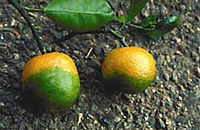
Susceptibilities of Candidatus Liberibacter asiaticus‐infected and noninfected Diaphorina citri to entomopathogenic fungi and their detoxification enzyme activities under different temperatures
Sign Up to like & getrecommendations! Published in 2018 at "MicrobiologyOpen"
DOI: 10.1002/mbo3.607
Abstract: Some entomopathogenic fungi species, Isaria fumosorosea, and Hirsutella citriformis were found to be efficient against the Asian citrus psyllid, Diaphorina citri Kuwayama (Hemiptera: Liviidae). However, the susceptibility to these fungi increases when the psyllid infected… read more here.
Keywords: detoxification; entomopathogenic fungi; candidatus liberibacter; liberibacter asiaticus ... See more keywords

A survey of ‘Candidatus Liberibacter solanacearum’ in historical seed from collections of carrot and related Apiaceae species
Sign Up to like & getrecommendations! Published in 2017 at "European Journal of Plant Pathology"
DOI: 10.1007/s10658-017-1322-6
Abstract: The occurrence of ‘Candidatus Liberibacter solanacearum’ (Lso) was determined in commercial and wild species of the family Apiaceae, obtained from three seed collections held in the United Kingdom. The accessions dated from the 1970s and… read more here.
Keywords: seed; apiaceae species; liberibacter solanacearum; candidatus liberibacter ... See more keywords

Citrus huanglongbing in Argentina: detection and phylogenetic studies of Candidatus Liberibacter asiaticus
Sign Up to like & getrecommendations! Published in 2017 at "Australasian Plant Pathology"
DOI: 10.1007/s13313-017-0473-4
Abstract: Huanglongbling (HLB) is one of the most devastating diseases of citrus trees. In Argentina, Candidatus Liberibacter asiaticus (CLA) –the causal agent of HLB- was detected for the first time in Misiones province in 2012 in… read more here.
Keywords: detection; cla; candidatus liberibacter; liberibacter asiaticus ... See more keywords

Seasonal incidence of ‘Candidatus Liberibacter asiaticus’ (Rhizobiales: Rhizobiaceae) in Diaphorina citri (Hemiptera: Liviidae) in Colima, Mexico
Sign Up to like & getrecommendations! Published in 2017 at "Tropical Plant Pathology"
DOI: 10.1007/s40858-017-0175-z
Abstract: By April 2016, 22 out of the 24 citrus-producing states in Mexico had confirmed the presence of ‘Candidatus Liberibacter asiaticus’ (C. Las) in citrus trees and in the vector Diaphorina citri. The dissemination of C.… read more here.
Keywords: colima mexico; candidatus liberibacter; diaphorina citri; liberibacter asiaticus ... See more keywords

Impact of HLB on the physiological quality of citrus rootstock seeds and non-vertical ‘Candidatus Liberibacter asiaticus’ transmission
Sign Up to like & getrecommendations! Published in 2020 at "Tropical Plant Pathology"
DOI: 10.1007/s40858-020-00371-8
Abstract: Huanglongbing (HLB) is the main disease of citriculture worldwide, being mainly caused by the bacterium known as ‘Candidatus Liberibacter asiaticus’ (CLas), limited to the phloem and naturally transmitted by vector insects known as psyllids. For… read more here.
Keywords: seed; transmission; physiological quality; candidatus liberibacter ... See more keywords

QTL and eQTL mapping associated with host response to Candidatus Liberibacter asiaticus in citrandarins
Sign Up to like & getrecommendations! Published in 2020 at "Tropical Plant Pathology"
DOI: 10.1007/s40858-020-00372-7
Abstract: Huanglongbing (HLB) is a severe disease of citrus caused by the bacterium Candidatus Liberibacter. In America, the most common species is Candidatus Liberibacter asiaticus (CLas). In a previous study of the Citrus-HLB pathosystem, our group… read more here.
Keywords: associated host; eqtl mapping; qtl eqtl; host response ... See more keywords

‘Candidatus Liberibacter asiaticus’ putative effectors: in silico analysis and gene expression in citrus leaves displaying distinct huanglongbing symptoms
Sign Up to like & getrecommendations! Published in 2020 at "Tropical Plant Pathology"
DOI: 10.1007/s40858-020-00382-5
Abstract: Huanglongbing (HLB) is considered the most devastating bacterial disease in citriculture. It is caused by the phloem-limited α-proteobacterium ‘Candidatus Liberibacter asiaticus’ (CLas). All citrus varieties are susceptible to HLB and many studies have been conducted… read more here.
Keywords: putative effectors; candidatus liberibacter; expression; liberibacter asiaticus ... See more keywords

'Candidatus Liberibacter asiaticus' peroxiredoxin (LasBCP) suppresses oxylipin-mediated defense signaling in citrus.
Sign Up to like & getrecommendations! Published in 2019 at "Journal of plant physiology"
DOI: 10.1016/j.jplph.2019.03.001
Abstract: The Lasbcp (CLIBASIA_RS00445) 1-Cys peroxiredoxin gene is conserved among all 13 sequenced strains of Candidatus Liberibacter asiaticus, the causal agent of Huanglongbing or "citrus greening" disease. LasBCP was previously characterized as a secreted peroxiredoxin with… read more here.
Keywords: peroxiredoxin; lasbcp; candidatus liberibacter; liberibacter asiaticus ... See more keywords

Development of a sensitive and reliable droplet digital PCR assay for the detection of ‘Candidatus Liberibacter asiaticus’
Sign Up to like & getrecommendations! Published in 2018 at "Journal of Integrative Agriculture"
DOI: 10.1016/s2095-3119(17)61815-x
Abstract: Abstract Citrus Huanglongbing (HLB, yellow shoot disease) is one of the most serious citrus diseases worldwide. To better improve the detection sensitivity, a droplet digital PCR (ddPCR) assay was developed for the rapid detection of… read more here.
Keywords: detection; droplet digital; detection candidatus; pcr ... See more keywords

Ecology and management of Bactericera cockerelli and Candidatus Liberibacter solanacearum in New Zealand
Sign Up to like & getrecommendations! Published in 2020 at "Journal of Integrative Agriculture"
DOI: 10.1016/s2095-3119(19)62641-9
Abstract: Abstract The psyllid Bactericera cockerelli was first reported in New Zealand in 2006 and spread quickly throughout all potato growing regions. In 2009, B. cockerelli was associated with the plant pathogenic bacterium Candidatus Liberibacter solanacearum,… read more here.
Keywords: new zealand; bactericera cockerelli; cockerelli; management ... See more keywords

Assessment of unconventional antimicrobial compounds for the control of ‘Candidatus Liberibacter asiaticus’, the causative agent of citrus greening disease
Sign Up to like & getrecommendations! Published in 2020 at "Scientific Reports"
DOI: 10.1038/s41598-020-62246-x
Abstract: In this study, newly identified small molecules were examined for efficacy against ‘Candidatus Liberibacter asiaticus’ in commercial groves of sweet orange (Citrus sinensis) and white grapefruit (Citrus paradisi) trees. We used benzbromarone and/or tolfenamic acid… read more here.
Keywords: assessment unconventional; treatment; asiaticus; candidatus liberibacter ... See more keywords